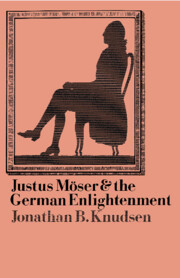Book contents
- Frontmatter
- Contents
- Preface
- Acknowledgments
- Abbreviations
- 1 Justus Möser in the German Enlightenment
- 2 Möser's social universe: urban notability and Enlightenment intelligentsia
- 3 Möser's political universe: secular politics in a confessional state
- 4 Moser's historical universe: regional history and cosmopolitan history
- 5 The party of incremental movement: social and economic reform in Möser's Osnabrück
- 6 Möser's social theory: local patriotism and the defense of the estates
- 7 The dialectic of Enlightenment: the debate over theory and practice
- Bibliography
- Index
1 - Justus Möser in the German Enlightenment
Published online by Cambridge University Press: 17 September 2009
- Frontmatter
- Contents
- Preface
- Acknowledgments
- Abbreviations
- 1 Justus Möser in the German Enlightenment
- 2 Möser's social universe: urban notability and Enlightenment intelligentsia
- 3 Möser's political universe: secular politics in a confessional state
- 4 Moser's historical universe: regional history and cosmopolitan history
- 5 The party of incremental movement: social and economic reform in Möser's Osnabrück
- 6 Möser's social theory: local patriotism and the defense of the estates
- 7 The dialectic of Enlightenment: the debate over theory and practice
- Bibliography
- Index
Summary
For more than three decades, Justus Möser was the dominant cultural, political, and administrative figure in the bishopric of Osnabrück. Made secretary to the noble Estate (the Ritterschaft) in 1742, while still a student, he began to gather offices and incomes in the fashion typical of institutional life in the old regime: he was appointed advocates patriae, the government's legal representative in foreign and domestic affairs (in 1747); syndic of the Ritterschaft (in 1755); justiciary in the criminal court (in 1756); and chief local administrator of the bishopric, its Geheim Referendar, during the absentee regency of its English bishop, Frederick of York (de facto in 1763 and formally in 1768). He was thus responsible – in fact, if not always in name – for Osnabrück's economic recovery after the Seven Years War and for its continued social and economic stability in the era before the French Revolution.
Möser could enjoy such political and administrative preeminence because the prince-bishopric (Fürstbistum) of Osnabrück, like a number of other small ecclesiastical states in northwestern Germany, had neither a resident prince-bishop nor a resident court, and this gave its administrators significant power. Through his numerous offices, Möser mediated between the semiautonomous Estates – nobility, towns, and cathedral chapter – and the Hanoverian chancellery in Hanover and London. Accepting the political system, he attempted to reconcile the various entrenched interests and pasted over areas of real and potential conflict. In the process, he gave new life to Osnabrück's moribund institutions and brought about reforms in the spirit of the European Enlightenment.
- Type
- Chapter
- Information
- Justus Möser and the German Enlightenment , pp. 1 - 30Publisher: Cambridge University PressPrint publication year: 1986

